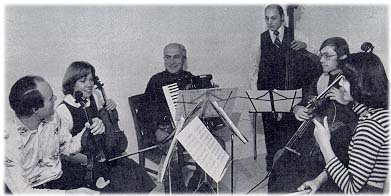"Many people who love music never thought of attending an accordion concert, but go regularly to chamber music series," observes Frank Hohner of M. Hohner, Inc. Thus, an entirely new accordion concept is being fostered on concert-goers as the instrument finds its place in ensembles. Educator Robert Davine, himself a concert performer, surveys this role.  Chamber
music may be defined as instrumental ensemble music performed by one player
to a part, as opposed to orchestral music, in which there are several players
to a part. Emphasis lies on the ensemble rather than the single player.
Instrumental ensemble pieces already existed in the late Middle Ages by
composers such as Obrecht, Isaac, Hofhaimer, and in the 16th century by
composers such as Willaert, Buus, and Padovano. Musicians to this day have
continued to value chamber music, primarily because it permits a refinement
and intimacy of expression that cannot be derived from a large musical organization. Chamber
music may be defined as instrumental ensemble music performed by one player
to a part, as opposed to orchestral music, in which there are several players
to a part. Emphasis lies on the ensemble rather than the single player.
Instrumental ensemble pieces already existed in the late Middle Ages by
composers such as Obrecht, Isaac, Hofhaimer, and in the 16th century by
composers such as Willaert, Buus, and Padovano. Musicians to this day have
continued to value chamber music, primarily because it permits a refinement
and intimacy of expression that cannot be derived from a large musical organization.Since the accordion has so many attributes that are conducive to chamber music, it is particularly suitable for this medium of expression. In essence, the accordion has all of the prerequisites essential to small ensemble involvement: sustaining power, dynamic sensitivity, articulated response, timbre and texture variance, and compatibility of sound with string and wind instruments. During the Baroque period (1600-1750), chamber music with some type of keyboard instrument (small organ, harpsichord) became prevalent with trio sonatas. This kind of chamber music is written in three parts with similar range and design and a supporting figured-bass part. The trio sonata is usually performed on four instruments: two violins for the upper parts, a cello for the bass part, and a keyboard instrument for the bass part with the realization of the thorough bass (harmony) accompaniment.  The
accordion, in the role of the keyboard part, maintains the clarity of sustained
lines that are essential to the character of this kind of music. Playing
the keyboard part on the accordion requires little or no modification -
especially if performed on an instrument, which has the extended potential
of a free bass system. Since the trio sonata was the most important type
of Baroque chamber music, almost all composers of this period wrote for
this medium. My performing experience has included the Trio Sonatas by Bach,
Handel, Telemann, Corelli and Arne. The
accordion, in the role of the keyboard part, maintains the clarity of sustained
lines that are essential to the character of this kind of music. Playing
the keyboard part on the accordion requires little or no modification -
especially if performed on an instrument, which has the extended potential
of a free bass system. Since the trio sonata was the most important type
of Baroque chamber music, almost all composers of this period wrote for
this medium. My performing experience has included the Trio Sonatas by Bach,
Handel, Telemann, Corelli and Arne.In the past 25 years, composers have utilized the accordion in a chamber setting with particular emphasis on its explosive dynamic power coupled with transparent sustained qualities. Examples of this kind of writing are found in Carmelo Pino's Concertino for strings and accordion, Night Music for string quartet and accordion by David Diamond, Movements for accordion and string quartet and Duell for accordion and percussion by Torbjorn Lundquist, Mosaic for flute and accordion by Normand Lockwood, Trio for guitar, violin and accordion by Jindrich Feld, Introduction and Allegro by Mathyas Seiber for cello and accordion and Trio for accordion, piano and cello by Ted Zarlengo. For the serious accordionist, it is difficult to conceive of a more challenging and satisfying musical effort than the involvement in chamber music. Working with other instruments gives one a completely new perspective about the accordion's unlimited musical resources and sound control, as well as musical understanding of how one's own part contributes to the overall shape of the composition. The accordion's function as the sound producer and controller within the ensemble must be thoroughly understood to be used most efficiently as the medium of expression, since music, by its very nature, is a living, breathing art. Among the benefits to be derived by utilizing the accordion in a chamber music setting is not only the musical content gained by the performer, but the fact that it also stimulates further special interest for other musicians. The use of the accordion in chamber music, for the most part, has remained obscure; its importance as an ensemble instrument has sometimes been misunderstood and many musicians, whose contact with this instrument has been limited, are unaware of its scope. To introduce the accordion to musicians and scholars, thereby removing the misconceptions about its quality and appeal, two things are necessary: musical understanding and sensitivity to and about playing a part, which while independent, should be amalgamated within the sound balance of the whole ensemble. Obviously, there is no one formula of requirements to become a fine chamber player, simply because music is such a personal experience - a quality to be much esteemed in our mass production age - that each player and listener draws a different benefit from it. For the accordionist, a completely new and untapped medium of expression is to be uncovered through the performance of chamber ensemble playing. The challenge is even more exciting because this medium as not yet been fully explored. |